Thursday, December 06, 2007
Hanging the Engine: Day 3
We've reached the stage in the process where all the exciting jobs have been done. Yellowbird now has an engine, and that engine now has a carburetor, ignition system, exhaust system, and a propeller. Most of the wires and hoses have been connected and now it's just a matter of finishing up the smaller details. Of course, in an airplane every detail matters, but they don't always make for interesting photography.
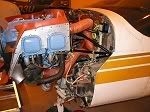 The most notable change from yesterday is that the new SCAT ducts for cabin heat and fresh air have been connected. The upper duct takes fresh air from an intake in the baffle above cylinder #4. The lower duct takes warm air from the heater shroud around the muffler below the engine. They both lead into the heater valve on the firewall, where a flap controlled by a knob in the cockpit controls the amount of fresh and heated air.
The most notable change from yesterday is that the new SCAT ducts for cabin heat and fresh air have been connected. The upper duct takes fresh air from an intake in the baffle above cylinder #4. The lower duct takes warm air from the heater shroud around the muffler below the engine. They both lead into the heater valve on the firewall, where a flap controlled by a knob in the cockpit controls the amount of fresh and heated air.
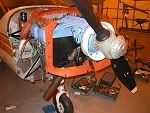 Up front, we see that the remainder of the orange rubber baffle seals have been installed. These provide a tight seal between the baffles and the inside of the engine cowlings. The idea is to encourage optimum airflow through the cooling fins on the cylinders.
Up front, we see that the remainder of the orange rubber baffle seals have been installed. These provide a tight seal between the baffles and the inside of the engine cowlings. The idea is to encourage optimum airflow through the cooling fins on the cylinders.
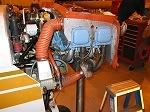 On the starboard side, Ray has finished the connections for the engine monitor temperature sensors and done a fine job of securing all the wires. The SCAT ducts for the oil cooler and carburetor heat have also been installed.
On the starboard side, Ray has finished the connections for the engine monitor temperature sensors and done a fine job of securing all the wires. The SCAT ducts for the oil cooler and carburetor heat have also been installed.
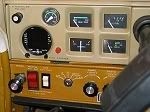 Inside, the new JPI EDM-700 engine monitor takes its place in the panel where the old exhaust gas temperature gauge used to live. Ray cut two holes in the panel overlay for the monitor's programming buttons. They don't extend past the overlay, so we may have to come up with some button extensions.
Inside, the new JPI EDM-700 engine monitor takes its place in the panel where the old exhaust gas temperature gauge used to live. Ray cut two holes in the panel overlay for the monitor's programming buttons. They don't extend past the overlay, so we may have to come up with some button extensions.
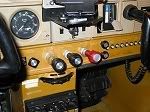 One more upgrade: I decided to replace the old push/pull mixture knob with a more precise vernier control (the large red knob). The vernier control operates just like the propeller RPM control: you twist the knob one way to increase, and the other way to decrease. In the case of the mixture, counterclockwise to lean, and clockwise to enrich. This makes it easier to make fine adjustments, and makes it less likely that you will pull the mixture to idle cutoff in-flight when you really intended to apply cabin heat. It happens, and the resulting silence is enough to ensure that you won't do it again. Well, maybe once more, but you'll learn your lesson after that.
One more upgrade: I decided to replace the old push/pull mixture knob with a more precise vernier control (the large red knob). The vernier control operates just like the propeller RPM control: you twist the knob one way to increase, and the other way to decrease. In the case of the mixture, counterclockwise to lean, and clockwise to enrich. This makes it easier to make fine adjustments, and makes it less likely that you will pull the mixture to idle cutoff in-flight when you really intended to apply cabin heat. It happens, and the resulting silence is enough to ensure that you won't do it again. Well, maybe once more, but you'll learn your lesson after that.
We're getting closer. There are still some non engine issues from the annual inspection as well as the IFR check to be done. It will probably be another week before everything is finished and Yellowbird can take to the sky again.

If there's no photograph, then it didn't happen! ;)
Seriously, it's great following along the process. Thanks for taking the time to document - I'm getting quite excited about seeing Yellowbird in the air.